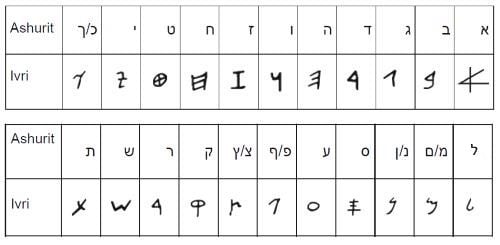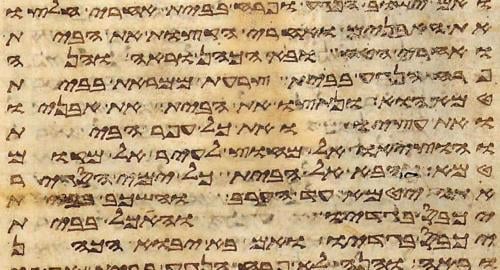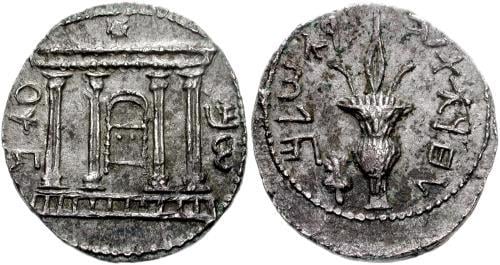Ivri: A Slippery Term
The Torah makes use of the term ivri (Hebrew) in select references to the Patriarchs and the children of Israel enslaved in Egypt. The term first appears in Gen. 14:13, in which Abram is called “the Hebrew.” Although the meaning of this term might seem obvious to us, it is noteworthy that the sages in Genesis Rabbah debate the term’s meaning in this context (41, Theodor-Albeck).
ויגד לאברם העברי – ר' יהודה א' כל העולם מעבר אחד והוא מעבר אחד, ר' נחמיה א' שהוא בא מעבר, ורבנן אמ' שהוא מעבר הנהר, ושהוא משיח בלשון עברי.
“And it was told to Abram the Hebrew” – Rabbi Yehudah says: “The entire world is on one side and he is on the other side.” R. Nehemiah says: “Since he is a descendent of Eber.” The Rabbis say: “That he is from the other side of the Euphrates (Josh. 24:3), and that he speaks Hebrew.”
The passage offers four different meaning for the term ivri. Radak (R. David Kimchi 1160-1235) combines them, noting:
העברי, מבני בני עבר, וכלם התיחסו אליו, אבל אברהם וזרעו התיחדו ביחס כי להם נשאר לשון עבר, והאחרים מבניו ובני בניו אחזו בידם לשון ארמי ונקראו ארמיים כמו לבן הארמי וזולתו, וזרע אברהם אשר ליעקב נקראו עברים.
“The Hebrew,” a member of the tribe of Eber, all his descendants named him as their ancestor, but Abraham and his descendants were singled out as his descendants since they still spoke Hebrew, the original language of man. Other descendants of his adopted the language of Aramaic, and were called Arameans, such as Laban the Aramean, and the like. But the offspring of Abraham through Jacob were called “Hebrews.”
Despite Radak’s creative attempt to combine the rabbinic interpretations, the multiplicity of the Sages’ answers speaks to the slippery nature of the term and its origins. Moreover, each of the rabbis’ answers highlight the key problems with the term: In some texts, it refers to Israelites, while in others, it seems to encompass something broader.
The Ivri-Ḥabiru Connection
Many modern scholars have argued that the term ivri is cognate with the Akkadian term Ḥabiru/Apiru, a group of people of lower economic and social standing who roamed the vast plains of Mitanni, Syria, and Palestine as serfs, brigands, half-citizens, and mercenaries through the second millennia and until the onset of the Iron Age.
While there is no scholarly consensus regarding the identification of ivri with Ḥabiru,[1] scholars agree that these Ḥabiru were not Israelites per se, or any other specific ethnic group. Instead, nearly all scholars today would agree with Nadav Naaman’s statement that,
[O]ne may safely conclude that the people designated as Habiru, who appeared at different places at different times in various Western Asiatic regions, had nothing in common apart from their similar social status. Each society had its own Habiru-people.[2]
This does not mean that no Israelites were Ḥabiru. Rather, as Niels Lemche has argued,
[T]he thought that the Hebrew of [the slave law in] Exodus 21:2 was necessarily an Israelite must be ruled out, but this does not exclude the possibility that he might have been.
Lemche takes this point further, and argues that impoverished Israelites might have joined the Ḥabiru and that it would have been difficult for the besieged Canaanites to distinguish between Hebrews and Israelites among “the roaming gang of robbers.”[3] In a similar vein, Yitzhaq Feder has argued that the Israelites may have adopted the derogatory term Ḥabiru as an ethnonym, “as a subversive expression of self-empowerment.”
But even if ivri is cognate with Ḥabiru, this does not mean that Ḥabiru and the biblical ivrim refer exactly to the same group. Yet, it is also unclear if we can even equate ivri with Israelite.
The Ivri in Genesis and Exodus
The term ivri, seemingly referring to Israelites, is used in the narratives of the Books of Genesis and Exodus in several ways, and under varying conditions, but disproportionately in the mouth of or in discussion with foreigners.[4]
In the Mouth of Foreigners
The biblical narrator puts the term ivri in the mouths of foreigners when they speak of an “Israelite”:
- Potiphar’s wife about Joseph (Gen. 39:14, 17).
- The chief cupbearer of Pharaoh about Joseph (Gen. 41:12).
- The king of Egypt speaking to the midwives about the Israelite women (Exod. 1:16).
- The daughter of Pharaoh when seeing the baby Moses (Exod. 2:6).
In the Mouth of Israelites
The biblical narrator also puts the term ivri in the mouths of Israelites when they are speaking to foreigners about themselves:
- The Israelite midwives to Pharaoh (Exod. 1:19).
- Miriam to the daughter of Pharaoh (Exod. 2:7).
- Moses to Pharaoh (Exod. 3:18, 5:3, 7:16, 9:1, 9:13).
Use by the Narrator
The “omniscient” narrator of the Torah also uses the term ivri to refer to Israelites, which might be more suggestive about the meaning of the term than the use by characters in the story.
- Ivri midwives versus other midwives (Exod. 1:15).[5]
- Moses saw an Egyptian hitting a ivri man (Exod. 2:11).
- Moses sees two ivrim fighting (Exod. 2:13).
Yet, concluding that ivri means Israelite would be hasty, as this may be an example of an association fallacy: the Israelites may be ivrim, but are all ivrim Israelites?
Ivri Must Mean a Broader Group
Until the establishment of Israel as a polity in Canaan, the name Israelite would have been merely a designation for a small clan, a descendant of Israel (=Jacob), and would likely not have conveyed much meaning to outsiders. Ivri, however, represented a far larger and better-known group (Ḥabiru) and, therefore, would have been the preferable form of self-identification to foreigners.[6] To this day it is quite common for the native groups in a country to refer to foreigners of similar backgrounds with one sweeping ethnic term.
Two biblical texts support this notion:
- “I was kidnapped from the land of the ivrim” (Genesis 40:15), Joseph tells the cupbearer in jail. This reference lacks meaning unless the narrator assumes that this land and its inhabitants, the ivrim, were well-known to the Egyptians. Moreover, these inhabitants cannot possibly be “Israelites” since there were no Israelites yet at this stage in the narrative—just a man named Israel and his sons.
- “The Egyptians could not eat with the ivrim, since that would be an abomination” (Gen. 43:32). This cannot possibly be a reference to “Israelites” in context, since there were no Israelites yet; the sons of Israel at this stage being literally the sons of the man Israel, not a people. It is striking, in fact, that the term bnei Yisrael, the children [literally!] of Israel, is not employed here. The use of the term ivrim here is likely meant to convey something like the Roman use of “barbarians” or the Babylonian's Umman-Manda, i.e., foreigners/rabble, in this case, with whom they would not sit at a table to dine. (In fact, we know that the Egyptians did have contempt for foreigners,[7] though we have no historical evidence about a prohibition of table fellowship with them.[8])
Thus it seems that from the Torah’s usage, ivri was a broad term about an ethnic or social group of which Israel was a part but not the exclusive representative. [9]
Hebrews and Israelites Under the Philistines
The use of ivri shifts somewhat in the book of Samuel, and is no longer used as a general epithet for foreigners or outsiders and is not a large umbrella group under which the Israelites are a small part. Even so, as we shall see, it does not specifically mean “Israelite” here either.
Samuel 13 describes the plight of Hebrews and Israelites under the Philistines, who held sway over large parts of Israel and were likely to have absorbed a significant number of Israelites either as war captives and/or as economically motivated serfs, that is, indigenous Israelites looking for work and economic security. 1 Samuel 13:19-20 describes the extent of the Philistines’ political, military, and economic domination during this period:
שמואל א יג:יטוְחָרָשׁ לֹא יִמָּצֵא בְּכֹל אֶרֶץ יִשְׂרָאֵל כִּי אמר [אָמְרוּ] פְלִשְׁתִּים פֶּן יַעֲשׂוּ הָעִבְרִים חֶרֶב אוֹ חֲנִית. יג:כוַיֵּרְדוּ כָל יִשְׂרָאֵל הַפְּלִשְׁתִּים לִלְטוֹשׁ אִישׁ אֶת מַחֲרַשְׁתּוֹ וְאֶת אֵתוֹ וְאֶת קַרְדֻּמּוֹ וְאֵת מַחֲרֵשָׁתוֹ.
1 Sam 13:19 No smith was to be found in all the land of Israel, for the Philistines were afraid that the ivrim would make swords or spears. 13:20 So all the Israelites had to go down to the Philistines to have their mattocks, axes, and colters sharpened.
In 1 Samuel, the designation ivri is put in the mouth of Philistines on five different occasions (1 Samuel 4:6, 9, 13:19, 14:11, 29:3), in each case, referring to the Israelites. But this does not prove that Israelite and ivri are coterminous; the Philistines may have used the term derisively, expressing contempt for the Israelites by using an ethnic slur other than a precise ethnonym (in particular 14:11, 29:3). This rhetorical use is supported by the fact that the Israelites refer to the Philistines in Samuel as “uncircumcised” (ערלים; 1 Sam 14:6, 31:4; 2 Sam 1:20), clearly meant as a derogatory slur and not as an ethnonym.
In fact, a careful reading of three places where the term is used implies that it does not have the same meaning as the term Israelite.
Exhibit A – “Let the Ivrim Hear”
1 Samuel 13:3-4 describes the beginning of the rebellion against the Philistines:
א שמואל יג:בוַיִּבְחַר לוֹ שָׁאוּל שְׁלֹשֶׁת אֲלָפִים מִיִּשְׂרָאֵל וַיִּהְיוּ עִם שָׁאוּל אַלְפַּיִם בְּמִכְמָשׂ וּבְהַר בֵּית אֵל וְאֶלֶף הָיוּ עִם יוֹנָתָן בְּגִבְעַת בִּנְיָמִין וְיֶתֶר הָעָם שִׁלַּח אִישׁ לְאֹהָלָיו. יג:גוַיַּךְ יוֹנָתָן אֵת נְצִיב פְּלִשְׁתִּים אֲשֶׁר בְּגֶבַע וַיִּשְׁמְעוּ פְּלִשְׁתִּים וְשָׁאוּל תָּקַע בַּשּׁוֹפָר בְּכָל הָאָרֶץ לֵאמֹר יִשְׁמְעוּ הָעִבְרִים. יג:דוְכָל יִשְׂרָאֵל שָׁמְעוּ לֵאמֹר הִכָּה שָׁאוּל אֶת נְצִיב פְּלִשְׁתִּים וְגַם נִבְאַשׁ יִשְׂרָאֵל בַּפְּלִשְׁתִּים וַיִּצָּעֲקוּ הָעָם אַחֲרֵי שָׁאוּל הַגִּלְגָּל.
1 Sam 13:2 Saul picked 3000 Israelites, of whom 2000 were with Saul in Michmas and in the hill country of Bethel, and 1000 with Jonathan in Gibeah of Benjamin; the rest of the people he sent back to their homes. 13:3 Jonathan struck down the Philistine prefect in Geba; and the Philistines heard about it. Saul had the ram’s horn sounded throughout the land, saying: “Let the ivrim hear!” 13:4 When all Israel heard that Saul had struck down the Philistine prefect, and that Israel had incurred the wrath of [lit., “become malodorous to”] the Philistines, then the people rallied to Saul at Gilgal.
The words “let the ivrim hear”[10] explain the purpose of sounding the ram’s horn.[11] The suggestion is that Saul is thereby alerting the ivrim to expect vengeful reprisals or that, alternatively, he is signalling them that freedom is at hand. The narrator then switches terms in v. 4, in which he uses “Israelites” as well as “the people” (ha-am). The text as we have it suggests that ivrim and Israelites are not interchangeable designations and that the narrator had two distinct groups of people in his purview: Israelites, and a second group, ivrim, serving as slaves to the Philistines, whom Saul wishes to free or, alternatively, wishes to invite to join the Israelite rebellion that he leads.[12]
Exhibit B – The Ivrim Crossed the Jordan
Two verses later, the text again seems to suggest that two distinct groups of people are fleeing from the Philistines:
א שמואל יג:ווְאִישׁ יִשְׂרָאֵל רָאוּ כִּי צַר לוֹ כִּי נִגַּשׂ הָעָם וַיִּתְחַבְּאוּ הָעָם בַּמְּעָרוֹת וּבַחֲוָחִים וּבַסְּלָעִים וּבַצְּרִחִים וּבַבֹּרוֹת. יג:זוְעִבְרִים עָבְרוּ אֶת הַיַּרְדֵּן אֶרֶץ גָּד וְגִלְעָד וְשָׁאוּל עוֹדֶנּוּ בַגִּלְגָּל וְכָל הָעָם חָרְדוּ אַחֲרָיו.
1 Sam 13:6 When the men of Israel saw that they were in trouble – for the troops were hard pressed – the people hid in caves, among thorns, among rocks, in tunnels, and in cisterns. 13:7 And ivrim[13] crossed the Jordan, [to] the territory of Gad and Gilead. Saul was still at Gilgal, and all the people[14] rallied to him in alarm.
If “the people” and ivrim are one and the same group, why is ivrim, rather than a pronoun (“they”) used in v. 7?[15] Sensing the difficulty, and on the assumption that ivrim and Israelites are one and the same entity, translators and commentators read “and some ivrim,” but the text does not say this. Instead, the reasonable inference is that ivrim does not refer to the “men of Israel” or to “the people.”[16]
Exhibit C – The Ivrim Joined the Israelites
A third related passage, later on in the story, offers the strongest evidence that ivrim and Israelites are not identical groups. While the verse is syntactically awkward,[17] its general thrust is clear. The Masoretic text, at 14:21, reads as follows:
שמואל א יד:כאוְהָעִבְרִים הָיוּ לַפְּלִשְׁתִּים כְּאֶתְמוֹל שִׁלְשׁוֹם אֲשֶׁר עָלוּ עִמָּם בַּמַּחֲנֶה סָבִיב וְגַם הֵמָּה לִהְיוֹת עִם יִשְׂרָאֵל אֲשֶׁר עִם שָׁאוּל וְיוֹנָתָן.
1 Sam 14:21 And the ivrim who had previously sided with the Philistines, who had come up with them in the army [from] round about – they too joined the Israelites who were with Saul and Jonathan.
The sense is that the ivrim, who had been with the Philistines all along, now, on seeing the tide turn, joined the Israelites. It is clear that the ivrim constituted a separate group of people from the Israelites. The classical commentators, no doubt challenged by the differing designations, explain that the ivrim were Israelites who had come under the control of the Philistines (Kimchi, Rashi, Levi Ben Gershon, etc.), i.e., though ethnically belonging to the Israelite nation, they were designated as ivrim and not as Israelites.[18]
Thus, we may infer that ivrim and Israelites in Samuel are two socially distinct but ethnically related groups of people. Ivrim appear to represent a low-standing socio-economic group of Israelites living among the Philistines as war slaves or serfs, and Saul and his people demonstrate solidarity and empathy for their plight.
The Relationship between Ivrim and Israelites
In the texts that describe the early periods of the patriarchs and the exodus, the term ivri refers to a broad group of people in the Levant (like the Ḥabiru), among whom the Israelites were a part. It is possible that, whatever the etymology of the term may have been, the Israelites who adopted the ethnonym ivri understood it as meaning “descendants of Eber” or, alternatively, as related in one way or another to Abraham, who was known by this epithet. The negativity of the term ivri in the mouth of the Egyptians, however, reflects the usage of Ḥabiru in the ANE, i.e., rabble, people outside the social order, or even refugee.[19]
In the description of the Philistine domination in the book of Samuel, ivri is no longer a general term for outsider or foreign rabble, but is a much narrower term. The ivrim and the Israelites clearly overlap and are ethnically affiliated, but the former are directly under the thumb of the Philistines and represent a poorer and more disenfranchised group.
This socio-economic usage is also reflected in the only law in the biblical legal corpora that uses this term: the ivri slave (Exod. 21:2-6), a piece of legislation designed to deal with the very scenario described in the Samuel account. The law extends protection against permanent enslavement to disenfranchised “Israelites” (ivrim), purchased by Israelites from their non-Israelite masters.[20] As a result of its lowly social connotation, the term ivri as a synonym for Israelite, fell into disuse and required an explanatory gloss.[21]










